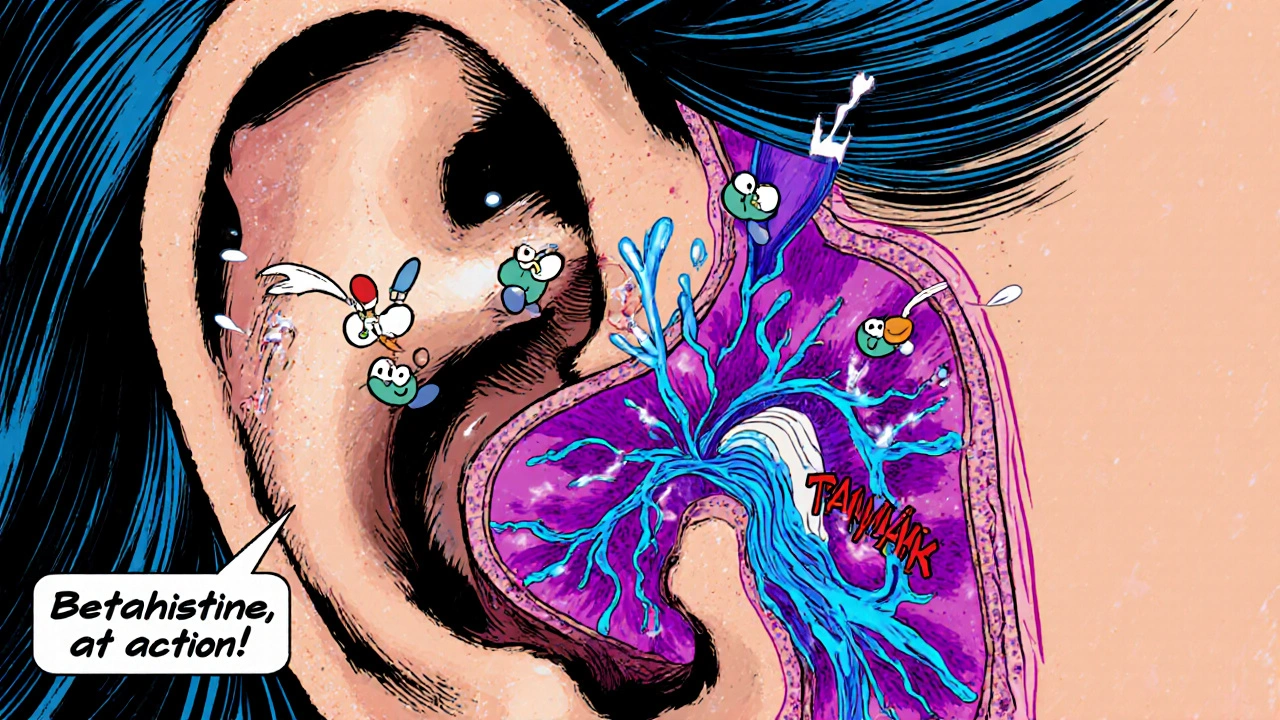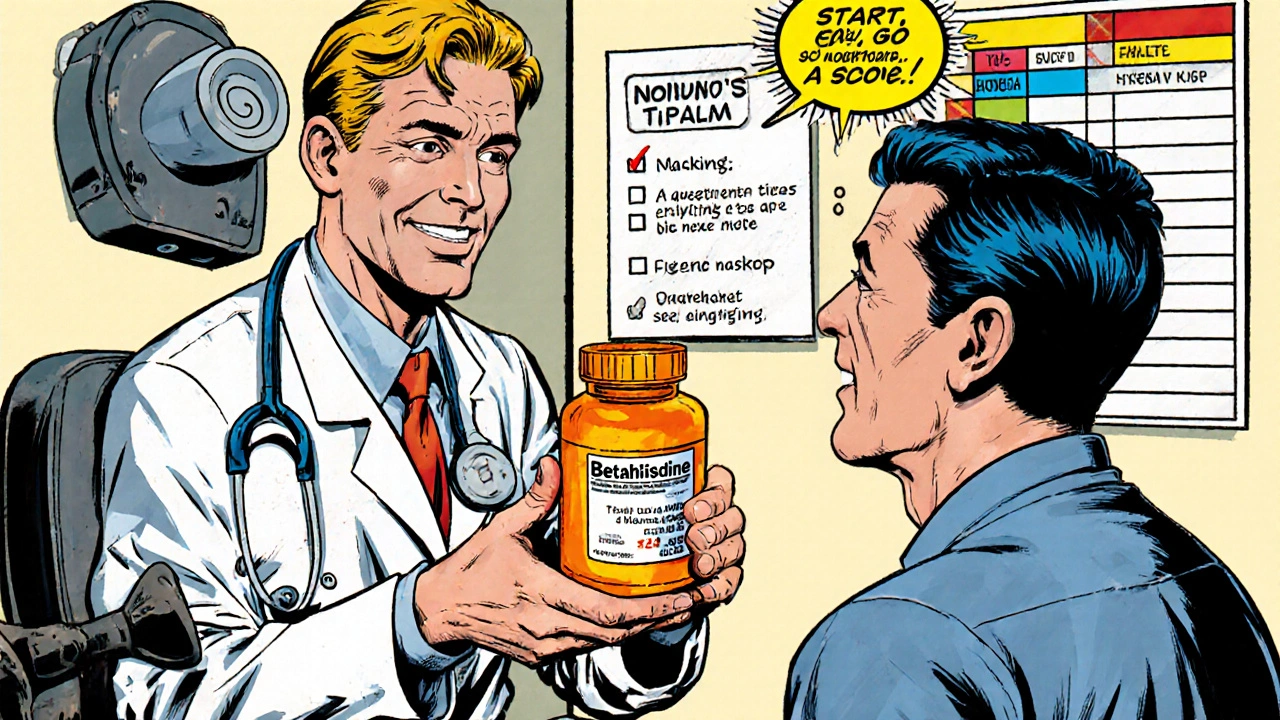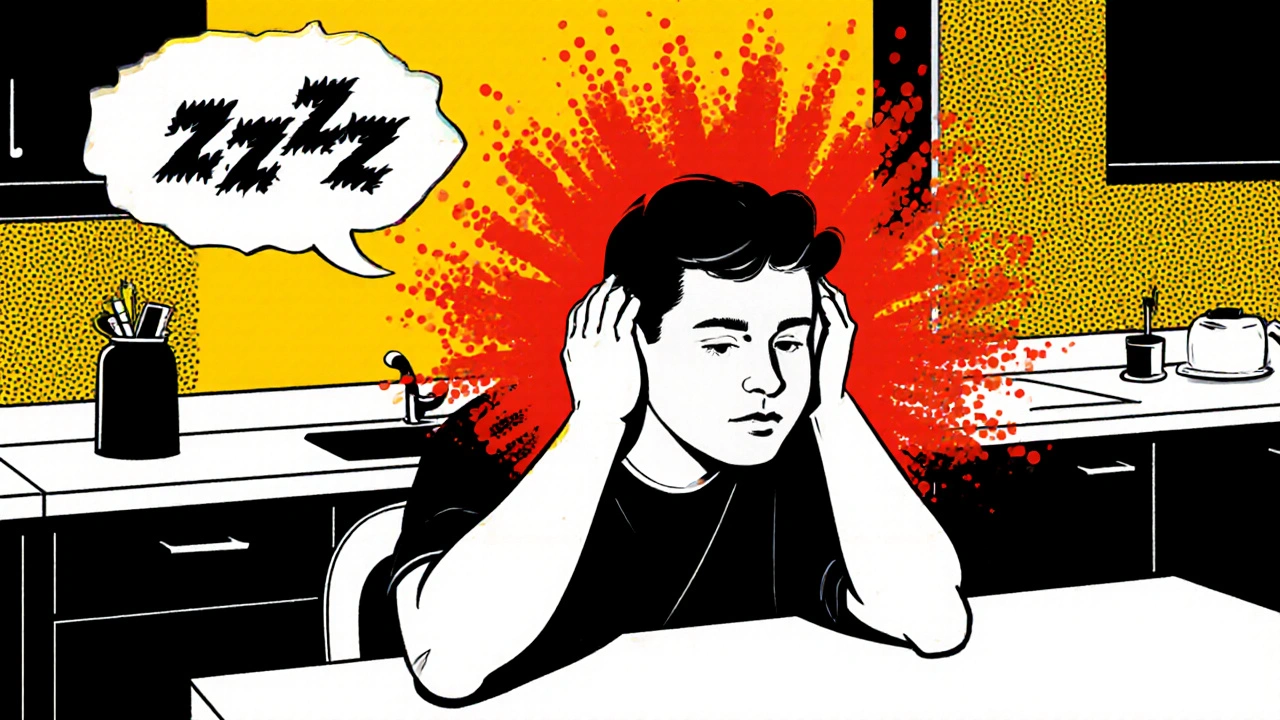Betahistine Tinnitus Dosage Calculator
Personalized Dosing Guide
Your personalized dosing recommendation:
Starting Dose: 8 mg twice daily
Adjust based on your response after 2 weeks.
Key Considerations
The article notes that betahistine shows greatest benefit when vestibular symptoms are present (as indicated above). For pure tinnitus without dizziness, benefits may be limited.
Dose Titration Pathway
Week 1-2: Start Low
Begin with 8 mg twice daily. Take with food to reduce stomach upset.
Week 3-4: Evaluate Response
Reassess tinnitus severity. If >10-point improvement on THI scale, consider increasing to 16 mg twice daily.
Week 5+: Maintenance
Maximum recommended dose is 24-48 mg daily split into 2-3 doses. Higher doses offer no additional benefit and increase side effects.
Important Safety Note
Do not exceed 48 mg/day. Avoid if you have asthma, peptic ulcer disease, or are on MAO inhibitors. Monitor for headaches or nausea.
When ringing or buzzing in the ears won’t quit, many people wonder if there’s a pill that can help. Betahistine is a histamine analogue that’s been used for decades to treat balance disorders, and it’s often mentioned in the context of Tinnitus. This article breaks down the science, the clinical data, and the practical tips you need to decide whether betahistine belongs in your tinnitus management plan.
Key Takeaways
- Betahistine is a histamine‑like drug that improves inner‑ear blood flow and modulates neurotransmission.
- Evidence for tinnitus relief is mixed; benefits appear strongest in patients with concurrent vestibular dysfunction.
- Typical doses range from 8mg to 48mg per day, split into two or three doses.
- Side effects are usually mild (headache, gastrointestinal upset), but monitoring is essential for people with asthma or ulcer disease.
- Betahistine works best as part of a broader plan that includes sound therapy, counseling, and lifestyle tweaks.
What Betahistine Actually Is
Betahistine is a synthetic analogue of the neurotransmitter histamine. It primarily acts as an antagonist at the Histamine H3 receptor, which normally inhibits the release of other histamines. By blocking H3, betahistine boosts histamine levels at the Histamine H1 receptor, leading to vasodilation in the inner ear’s stria vascularis. In plain language, the drug widens blood vessels in the cochlea, improving oxygen and nutrient delivery.
Why Inner‑Ear Blood Flow Matters for Tinnitus
Most of us think of tinnitus as a purely auditory problem, but the inner ear’s health is tightly linked to the auditory nerve’s firing patterns. When blood flow drops, the hair cells can become stressed, sending erratic signals that the brain interprets as ringing. By increasing microcirculation, betahistine aims to stabilize those signals.
Research also suggests that the drug may modulate neurotransmitter balance in the dorsal cochlear nucleus, a brainstem hub that can amplify phantom sounds. The net effect is a potential reduction in the perceived loudness or annoyance of tinnitus.
Who Might Benefit? The Vestibular Connection
Clinical observations consistently note that patients with both tinnitus and vestibular dysfunction (like Ménière’s disease or vestibular migraine) report the greatest relief from betahistine. This makes sense because the drug was originally approved for vertigo and balance disorders.
If you have pure‑tone tinnitus without any dizziness, the evidence is thinner. In those cases, betahistine may still help, but expectations should be modest.

Evidence Snapshot: What the Studies Show
Over the past 20years, dozens of trials have examined betahistine for tinnitus, but results vary widely. Below is a quick look at the most frequently cited data.
| Year | Design | Sample Size | Dosage | Primary Outcome | Result |
|---|---|---|---|---|---|
| 2003 | Randomized, double‑blind, placebo‑controlled | 84 | 24mg/day | Tinnitus Handicap Inventory (THI) change | Mean improvement 8points vs 2points placebo (p<0.05) |
| 2010 | Open‑label cohort | 56 (Ménière’s with tinnitus) | 48mg/day | Visual analogue scale (VAS) loudness | 30% reported >50% reduction |
| 2017 | Multicenter, double‑blind | 120 | 16mg three times daily | THI and quality‑of‑life score | No statistically significant difference |
| 2022 | Meta‑analysis of 12 RCTs (n=1,023) | Aggregate | Varied 8‑48mg/day | Standardized mean difference (SMD) | SMD=0.22 (small effect), heterogeneity high |
Bottom line: betahistine can provide a modest benefit for a subset of patients, especially those with vertigo‑related tinnitus. It’s not a miracle cure, but it’s a relatively safe adjunct.
How to Use Betahistine Safely
- Start low, go slow. Most clinicians begin with 8mg once or twice daily, then titrate up based on tolerance.
- Take with food. This reduces occasional stomach upset.
- Watch for side effects. Headache, nausea, and mild flushing are the most common. If you have asthma, a history of ulcers, or are on MAO‑inhibitors, discuss risks with your doctor.
- Stick to the schedule. Betahistine has a short half‑life (about 3hours), so splitting the dose helps maintain steady blood levels.
- Combine with other therapies. Sound enrichment, CBT, and hearing aids often amplify the drug’s impact.
Potential Pitfalls and Myths
There are a few misconceptions floating around the internet:
- Myth: Betahistine cures tinnitus permanently.
Reality: It may reduce perceived loudness while you’re on it, but symptoms often return after stopping. - Myth: Higher doses guarantee better results.
Reality: Doses above 48mg/day show no extra benefit and increase side‑effect risk. - Myth: It works for everyone with ringing ears.
Reality: Effectiveness is tied to underlying vestibular involvement; pure sensorineural tinnitus often shows limited change.

Regulatory Status and Availability
Betahistine is approved in many European and Asian countries for Ménière’s disease and vertigo. In Australia, the Therapeutic Goods Administration (TGA) lists it as a prescription‑only medicine, marketed under brand names such as Serc. In the United States, it is not FDA‑approved, so patients typically access it via compounding pharmacies or clinical trials.
Putting It All Together: A Sample Management Plan
Here’s a realistic roadmap for someone considering betahistine:
- Step 1 - Assessment. Get a full audiological evaluation to confirm the type of tinnitus and check for vestibular signs.
- Step 2 - Baseline. Record your THI score, VAS loudness, and any associated dizziness.
- Step 3 - Start Betahistine. Begin with 8mg twice daily for two weeks.
- Step 4 - Adjunct Therapy. Add low‑level sound generators or a smartphone masking app.
- Step 5 - Review. After four weeks, reassess THI. If you see a ≥10‑point drop, consider titrating to 16mg twice daily.
- Step 6 - Long‑Term Strategy. If benefits plateau, discuss tapering or switching to other options like Cognitive‑Behavioral Therapy (CBT).
Keeping a symptom diary helps you spot patterns-maybe you notice improvement on days you’re less stressed, hinting that lifestyle tweaks are just as important as the pill.
Frequently Asked Questions
Is betahistine safe for long‑term use?
Clinical experience shows it can be used for months to years with minimal serious adverse events. Routine liver function tests are advised for anyone on high doses for more than six months.
Can I buy betahistine over the counter?
In Australia and most European nations it’s prescription‑only. In the U.S. it’s not FDA‑approved, so you’ll need a specialist’s prescription or enroll in a clinical trial.
What dose is recommended for tinnitus?
Studies commonly use 16‑24mg per day, split into two doses. Some clinicians start at 8mg twice daily and increase based on tolerance.
Does betahistine interact with other medications?
It can enhance the effects of other antihistamines and may increase the risk of gastric irritation when combined with NSAIDs. Always tell your doctor about all current meds.
If I stop betahistine, will my tinnitus come back?
In many cases, the perceived loudness returns once the drug is cleared because the underlying inner‑ear condition remains. That’s why a multi‑modal approach is recommended.
Bottom Line
Betahistine isn’t a universal fix, but for people whose tinnitus is tangled up with balance problems, it can be a useful piece of the puzzle. Its safety profile is reassuring, and the cost is modest in regions where it’s approved. The smartest move is to treat it as an adjunct-pair it with sound therapy, stress management, and proper audiological care. Talk to an ear‑nose‑throat (ENT) specialist or audiologist, lay out your symptom scores, and let them guide the dosing. With realistic expectations and a holistic plan, you stand a better chance of dialing down that relentless ringing.


CHIRAG AGARWAL
October 17, 2025 AT 01:57Betahistine? More hype than help. The drug’s vasodilating trick sounds cool, but you still end up with the same ringing if the brain’s misfiring. Plus, the studies are all over the place – some show a tiny dip in THI, others nothing at all. It’s a cheap pill, sure, but cheap doesn’t mean effective. If you’re not already juggling vertigo, you’re probably just swapping one annoyance for another.
Bottom line: don’t expect miracles.
genevieve gaudet
October 17, 2025 AT 02:13i cant help but wonder if the ear is just a metaphor for the noise we carry inside us. betahistine tries to fix the sound, but maybe the real fix is quieting the mind. like, why are we so quick to pop a pill instead of asking why the ringing exists in the first place? sometimes the answer lies in stress, sleep, or the endless chatter of daily life. just a thought, no promises.
Mary Davies
October 17, 2025 AT 03:36Imagine standing on a cliff, the wind howling, and a constant whine echoing in your skull – that’s tinnitus. Betahistine swoops in like a knight in a white coat, promising relief. Yet the battle is waged in the brain’s circuits, not just the ear’s blood flow. My heart races just thinking about the promise of finally hearing silence. Will it be a hero or just another fleeting cameo? Only time will tell, but the drama of hope is real.
Rebecca Mitchell
October 17, 2025 AT 03:53Sounds like a risky gamble.
Roberta Makaravage
October 17, 2025 AT 05:00Betahistine has been around for decades, and the hype around it often eclipses the nuanced reality. First, the drug works by antagonizing histamine H3 receptors, which in theory boosts inner‑ear blood flow. In practice, that vasodilation can help some patients whose tinnitus is tied to vestibular dysfunction, but it’s not a magic bullet. The literature, as the article points out, shows a modest effect size – think of it as a faint whisper rather than a roar. For those with Ménière’s disease, the improvement can be noticeable, yet many studies report no statistically significant benefit for isolated tinnitus. Moreover, the dosage window is narrow; you’ll find that 8 mg twice daily is often a starting point, and titrating up beyond 48 mg rarely adds value. Side effects such as mild headaches or stomach upset are generally tolerable, but caution is advised for patients with asthma or ulcer histories. The drug’s half‑life is short, meaning you have to split the dose to keep plasma levels stable, which can be inconvenient for some. From a mechanistic standpoint, the modulation of the dorsal cochlear nucleus is intriguing, suggesting central nervous system involvement beyond simple blood flow. However, the heterogeneity of trial designs – differing endpoints, variable patient populations – makes it hard to draw firm conclusions. Pragmatically, betahistine should be viewed as an adjunct, not a stand‑alone cure; pairing it with sound therapy, CBT, or lifestyle changes yields the best outcomes. Clinicians often recommend a diary to track changes, because subjective improvement can be subtle and influenced by stress levels. On the regulatory side, it’s approved in many countries for vertigo, but in the U.S., you’ll need a specialist’s prescription or a compounding pharmacy. Ultimately, if you’re willing to experiment under medical supervision, the risk‑benefit profile is relatively favorable, especially compared to more invasive interventions. So, keep expectations realistic, stay consistent with dosing, and remember that the road to quieter ears is usually a multi‑modal journey. 😊
Lauren Sproule
October 17, 2025 AT 06:23Thanks for breaking it down so clearly! I appreciate the balanced view and the reminder that a holistic plan works best. It’s good to know the risks are low when monitored properly. I’ll definitely talk to my ENT about trying it alongside sound therapy.
Miriam Rahel
October 17, 2025 AT 07:46Having perused the evidence, one must acknowledge that the marginal benefit reported in meta‑analyses is statistically negligible. The pharmacological rationale, while sound, fails to translate into clinically significant improvement for the majority of sufferers. Consequently, the prescription of betahistine without concomitant therapeutic modalities appears unjustified.
RJ Samuel
October 17, 2025 AT 10:33Honestly, I think the whole betahistine hype is a distraction. The industry loves to push a cheap pill while ignoring lifestyle factors that are far more impactful. If you ask me, you’d be better off focusing on diet, exercise, and stress reduction rather than chasing a modest pharmacological effect.
Patricia Echegaray
October 17, 2025 AT 11:56Don’t you see? Big Pharma funds the “studies” that push betahistine, ensuring they keep us dependent on their products. Meanwhile, they suppress natural remedies and alternative approaches that could actually solve the problem. It’s all a coordinated effort to keep the money flowing.
Sara Werb
October 17, 2025 AT 13:20Wow!!! This entire discussion feels like a roller‑coaster of hope, disappointment, and endless promises!!! Betahistine is tossed around like a miracle drug, yet the data is as shaky as a house of cards!!! People cling to any shred of relief, even if it’s just a whisper in the storm!!!
Winston Bar
October 17, 2025 AT 14:43At the end of the day, betahistine is just another pill that might work for a lucky few – not worth the hype.